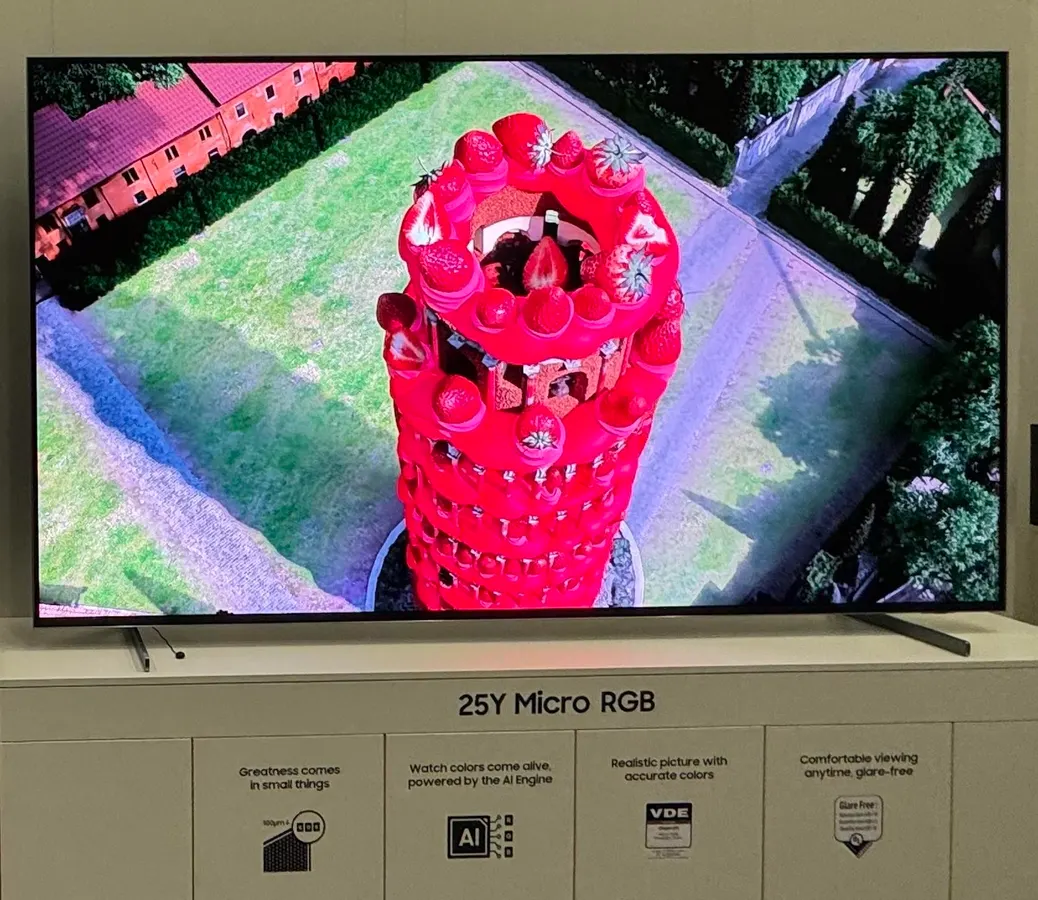By John Archer,Senior Contributor
Copyright forbes

After a few years of starting to feel less and less like a key part of the AV industry calendar, the annual IFA technology show in Berlin exploded back onto the scene this September on the back of a veritable avalanche of major technology and product announcements. Chief among which was a concerted push to introduce the world to a new type of ‘true RGB’ LED TVs, where tiny dedicated red, green and blue LEDs are used to produce colour rather than the usual LCD TV approach of shining white or blue light through colour filters.
Hisense was showing its already launched 116-inch ‘RGB MiniLED’ TV, as well as a much smaller and presumably much more affordable 85-inch model set for launch next year. Sony was running a dazzling behind-closed-doors demo of the latest iteration of the 75-inch ‘independent drive RGB LED’ screen I first got to see back in February. And Samsung was going large – literally – with its new 115-inch Micro RGB screen.
The purity and range of Samsung’s debut Micro RGB TV has to be seen to be believed.
Photo: John Archer
As its name suggests, this monster Samsung screen uses significantly smaller (sub 100 micron) independent red, green and blue LEDs than those use in other new takes on RGB LED technology. Something Samsung was keen to prove in an IFA tech demo by showing the LEDs of its Micro RGB set under a microscope alongside the much larger LEDs used in Hisense’s 116UX RGB MiniLED TV. The idea behind its smaller LEDs being, according to Samsung, to provide even more precision in the delivery of the much wider colour gamuts and volumes RGB LED technology is capable of.
In fact, Samsung was so confident about its Micro RGB take on RGB LED technology TV that it was prepared to let me spend a couple of hours of proper one on one time in a private room away from the main IFA show floor with what was essentially a finished version of its 115in Micro RGB debutante. What’s more, during this hands on I was left completely to my own devices, was able to test it with any source content I liked, play with any settings I liked, and adjust the room lighting in any way I liked, including creating full black out conditions if I so desired. And what I witnessed underlined in bright red ink my feeling that the TV world is about to be rocked by another glorious sea-change in TV picture quality.
Before getting into the difference Micro RGB tech makes to picture quality, though, I should say that the first thing that struck me about Samsung’s 115-inch TV was the sheer size of its screen. I’ve almost become used to sitting in front of 98 or 100-inch TVs now, but the extra 15 inches you get here is transformational when it comes to achieving a truly cinematic experience that truly fills your field of view.
MORE FOR YOU
It’s impossible to do justice in photographs to the true intensity but also subtlety of the Samsung Micro RGB TV’s color range. This is probably my best attempt at capturing a sense of it, though.
Photo: John Archer
The ability of Samsung’s new screen to completely transfix your gaze is done no harm whatsoever by the fact that it’s capable of blasting out extraordinary levels of brightness. Samsung wouldn’t share an official peak brightness figure, but I have no doubt that I was looking at HDR peaks in the numerous thousands of nits – as well as levels of brightness with HDR content that floods the whole screen with light that took my breath away (and crushed anything even the best new OLED TVs can achieve with the same content).
It was surprising after witnessing this stunning brightness on a 115-inch screen to have Samsung confide to me that while it wouldn’t confirm the official brightness figures for its debut Micro RGB TV, it couldn’t claim a peak brightness level as high as the 8,000 nits being claimed by Hisense for its 116-inch “RGB MiniLED” 116UX TV. Having had the chance to fully measure and test that Hisense TV recently, though, I know that it only hits 8,000 nits (actually 8,400 nits) if you set it to its Dynamic picture preset and manually select an AI Brightness Boost feature – settings which, while greatly boosting peak brightness, actually make the Hisense’s pictures look worse overall. It’s telling that Hisense’s RGB MiniLED TV debut doesn’t actually activate the AI Brightness Boost feature by default on any of its picture presets – even the Dynamic one.
With the AI Brightness Boost left off as I’d recommend, the 4,400 or so nits of peak brightness the Hisense screen drops back to doesn’t yield pictures that look as radiant and luminous as those of the Samsung Micro RGB screen. And the Samsung screen isn’t having to deploy any excessively out there, image-spoiling brightness boost technologies to achieve its remarkable brightness. Instead it feels like the screen is producing its extreme brightness entirely naturally without any aspects of its imaging looking like they’re being put under any sort of strain.
Life is sweet with Samsung’s Micro RGB technology…
Photo: John Archer
The high brightness of the Micro RGB screen joins with its pure red, green and blue LEDs to deliver colors that stretch miles beyond anything I’ve seen before on a consumer television. This is particularly noticeable with relatively pure HDR primary colors of the sort found in animated content – or the specially created ultra bright, ultra-colorful demo content reel Samsung provided for use alongside the “real world” content I was able to feed it myself. But the vast color volume actually feeds into every frame of everything you watch using the TV’s default (once you’ve turned off the set’s brightness-limiting Eco features) Standard picture preset.
Remarkably the Micro RGB’s color range appeared to extend fairly comfortably beyond the outer limits of Hisense’s 116UX – something which as well as enabling the Samsung screen to deliver even more vibrant and spectacular colors also allows it to maintain a more consistent color palette from shot to shot than its Hisense rival does. Reds, in particular, maintain unprecedented purity and vibrancy even at huge brightness levels on the Samsung, while they can look strangely purply or brown on the rival screen.
Feeding the Samsung Micro RGB screen the 4K HDR street festival sequence from Guy Ritchie’s live action Aladdin on 4K Blu-ray feels like watching this oft-used demo clip for the very first time, so much more luminosity, vibrancy and color volume does it enjoy on Samsung’s 115-inch screen than it does on any other screen I’ve ever seen it on. Including the Hisense RGB MiniLED – despite that rival screen itself delivering richer saturations and higher color volumes than any previous TV I’d seen at the time I tested it.
Real world content such as the 4K Blu-ray of ‘Aladdin’ is presented by Samsung’s Micro RGB technology with much bolder colors than I’ve seen it on any other screen – yet skin tones remain convincing and every tone in the expanded palette feels in perfect balance with all the rest.
Photo: John Archer
A play through of a few scenes from the Deadpool & Wolverine 4K Blu-ray merely confirms that Samsung’s Micro RGB screen is capable of taking color to a whole new level of spectacular, as, for instance, the red and yellow suits of the film’s heroes and the fiery look of the glowing circular portals our heroes use to ‘fast travel’ display a level of pop and intensity that had me shaking my head in amazement.
As important as the stunning color punch and vibrancy of Samsung’s debut Micro RGB TV, though, is the way it delivers its unprecedented color expansion with Aladdin and Deadpool & Wolverine without any tone, not even skin tones, looking unnatural or out of kilter with the rest of the image. It’s all just absolutely, next-generationally, ultra-immersively gorgeous.
Not everything is a cartoon
While the extreme color range opened up by Samsung’s Micro RGB technology is the most striking part of the 115-inch Micro RBG performance, I also became aware over time of just how much subtlety the screen achieves with its color portrayal. There’s seldom anything cartoonish or flat about the Samsung’s color appearance; on the contrary, the fine blending and ultra nuanced tonal shifts it delivers play a key role in making its pictures look significantly sharper and more three-dimensional than those of the Hisense 116UX. So much so that that other RGB LED-toting screen’s pictures actually look quite soft by comparison. This really proves again how game-changing the Micro RGB screen is in more ways than just the expanded color palette it produces.
It’s not just its ground-breaking new hardware approach that makes the Samsung Micro RGB screen’s pictures so nuanced (an achievement which is, of course, a particularly big deal when you’re talking about a screen that’s 115 inches across). Its specially designed in the way AI-influenced processor also appears to be playing a key role in unlocking the screen’s unprecedented full potential.
The abilities of this processor became even more obvious when I fed fairly grubby, compressed looking and/or grainy HD footage (including a 720p feed) into Samsung’s new screen. Samsung’s processor managed to upscale this content to the Micro RGB’s native 4K screen remarkably cleanly, removing practically all blemishes and noise from the source before getting down to the business of adding millions of extra pixels to the picture. Similar relatively low-rent content played on to the Hisense 116UX, by comparison, looks like it’s appearing behind a filter of laggy ‘fizz’.
Other benefits
Samsung’s Micro RGB screen has a couple of further huge aces up its sleeve that (I don’t think) are directly connected to the Micro RGB lighting structure. First, its screen is remarkably effective at suppressing reflections. Even with the harsh lighting available in the IFA demonstration room turned right up, my connection with the vast images Samsung’s Micro RGB was pumping out was scarcely broken at all by the presence of any reflections lying across the screen. This filter appears to work pretty much as well as the ones found on Samsung’s latest S95F OLED TVs – and its impact is even more game-changing at the 115-inch screen size.
The backlight performance of Samsung’s 115-inch Micro RGB TV is better – by far – than any other LED TV lighting system I’ve ever seen.
Photo: John Archer
The final dazzling attraction of Samsung’s 115-inch Micro RGB TV is its astonishingly good backlight control. Samsung claims a remarkable 15,000 separately control local dimming zones for its new flagship TV. Since this number is based on control of the individual R, G and B mini LEDs, though, 5000 dimming zones is actually a truer zone count if you consider the Micro RGB’s set up in the same way we discuss regular LED TV local dimming – but watching a particularly dark HDR sequence from Netflix’s Sandman show revealed easily the best backlight performance I’ve ever seen from an LCD TV.
The screen delivered, for instance, beautifully deep, rich black colours for the night sky of the sequence in question while simultaneously delivering a bright highlight of a flaming torch right against that dark night sky with dazzling intensity. What’s more, this incredibly intense example of local contrast was delivered without any noticeable blooming or haloing around the flaming torch highlight.
Leave no detail behind
Even better, the local dimming system somehow manages to bring out even the faintest shadow details in the darkest areas of the Sandman sequence, rather than crushing them out into the blackness. Without, again, causing any local blooming noise or general clouding/greyness interference.
This outstanding uniformity of the backlight system even with this most difficult content to handle also helps Samsung’s Micro RGB screen retain outstandingly vibrant and natural colors during dark scenes.
My tests of the Hisense 116UX, by comparison, revealed much more evidence of clouding, haloing and color shift. To be clear, when I tested that Hisense screen in isolation, I was mostly impressed by its backlight control and performance. But Samsung’s 115-inch Micro RGB screen takes LED backlighting to a whole new level of performance I’ve never seen before. For most of the time it’s like watching a 115-inch OLED TV, in fact. Only one with more peak and, especially, full screen brightness and even more far-reaching color than any actual OLED I’ve ever seen.
Even watching Samsung’s Micro RGB screen from wide viewing angles doesn’t cause blooming to become more obvious or its brilliant black levels to fall away.
Struggles with niggles
Niggles with Samsung’s Micro RGB TV were hard to find during my time with it – but I came up with one or two. First, the TV’s mostly brilliant upscaling system can leave the grubbiest HD sources looking a touch too scrubbed of detail – though this is certainly vastly preferable on a screen as unforgivingly large as 115-inch to a potentially sharper upscaled picture that contains lots of noise and grain.
Occasionally the very brightest parts of HDR pictures show minor clipping (lost shadow detail), and some of the brightest blues could take on a slightly cyan tone. Though both of these issues pretty much disappear if you switch to the TV’s Movie or Filmmaker Mode presets.
The extent to which Samsung’s Micro RGB screen has to rein itself in to deliver the accuracy-based pictures of the Filmmaker Mode perhaps raises the philosophical question of whether the sort of brightness, contrast and especially color extremes Samsung’s new screen technology is capable of are really necessary in a world where content is typically mastered relatively conservatively. My reply on this would be, though, that as well as providing an accuracy-based Filmmaker Mode for movie night purists, the way the Micro RGB TV’s Standard mode expands content to fill more of the screen’s picture quality “bucket” delivers more balanced and believable results than you’d probably imagine possible for a screen of such extreme talents.
Plus, of course, there’s always the “if you build it, they will come” argument, where the creative industries may be more likely to consider expanding their mastering mindset when the hardware exists to make such an expansion reproducable in living rooms.
RGB LED technologies are off to a flier
We’re starting to veer off into hypothetical waters there, though, rather than remaining focused on the simple here and now fact that Samsung’s Micro RGB TV not only reiterates the potentially massive impact of RGB LED technologies on the immediate future of the TV market, but also sets a spectacular new bar for RGB LED-type technologies that already surpasses the bar set only weeks ago by the world’s first RGB LED TV to come to the market.
Samsung’s 115 Micro RGB TV is confirmed now to be retailing for the undeniably eye-watering sum of $29,999/£27,999. That’s a fair bit more than the $24,999/£24,999 Hisense is asking for its 116UX RGB MiniLED TV. Samsung’s screen performs well enough, though, to pretty easily justify its extra cost over the 116UX.
Even more importantly given how few of us can scrape together tens of thousands of dollars or pounds for a TV, Samsung publicly stated at IFA that it is fully committed to Micro RGB, and will be looking to bring smaller and presumably much more affordable Micro RGB screens to market from next year onwards. So there should still be plenty for AV fans who don’t have endlessly deep pockets to get excited about in the months and years to come.
Related Reading
Editorial StandardsReprints & Permissions



